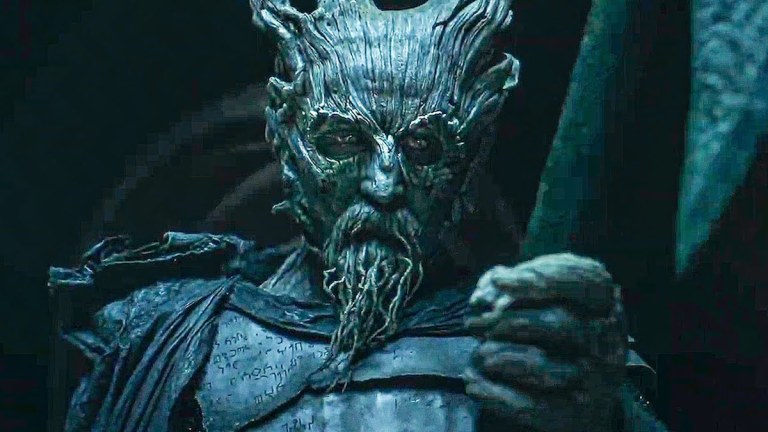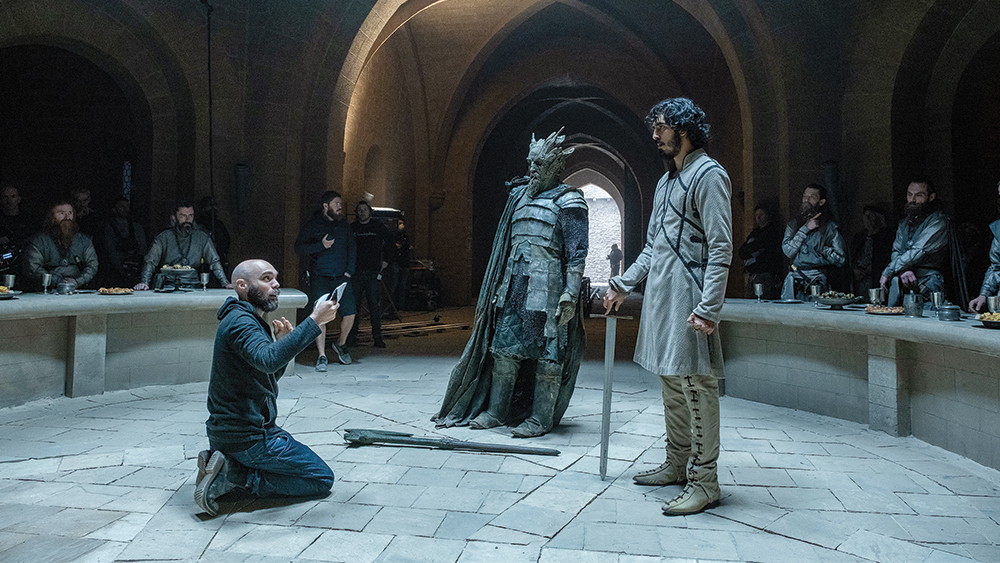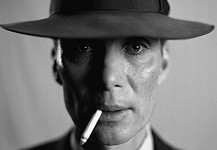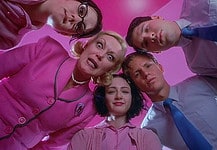Last Updated on July 28, 2021, 12:39 PM | Published: July 28, 2021
After cutting his teeth on stark, Southern, emotional drama with 2013’s “Ain’t Them Bodies Saints,” writer/director David Lowery began dipping his toes into magical realism and pseudo-surrealism, to international acclaim, with “Pete’s Dragon” and “A Ghost Story.”
Now, seemingly looking to finally pay off those fantastical impulses more completely, he dives headfirst into the sword-and-sorcery world of “The Green Knight,” and along the way, crafts a film of such stunning beauty and earnest introspection that it may very well be the film world’s best-ever Arthurian adaptation…
If you’ve seen the trailers, or indeed even the poster images, for “The Green Knight,” it should come as no surprise that the photography on display here is masterful and vivid.
Everything from framing to coloration to the meticulous-yet-sparse set design is perfectly calibrated to capture the aesthetic of medieval artworks. Think of the lush tapestries and cracked church-wall frescos used to preserve and illustrate the era’s fables.
Everything is viewed through a thick fog, from a distance down a dark hallway, or framed and outlined by twisting, entwined branches, each moment as fully committed to its painterly visual style as to its sincere, poetic storytelling.
And it’s that level of sincerity that will undoubtedly (and unfortunately) turn off a lot of audiences.
Music and film
by Brett Fieldcamp
Sponsored by True Sky Credit Union

From the opening moments, scored by crashing fanfare and laid-over with medieval script announcing “A cinematic adaptation of a chivalric romance,” Lowery remains unblinking in his belief that this story can, and should, be treated with a respect and a naked earnestness so rarely seen in recent filmmaking. There is no cheekiness in its magic. There are no nods to the camera or winks to the audience to signify an ironic self-awareness.
Lowery wholly avoids the half-hearted reassurance so often given by presenting characters as conduits for the modern attitudes of dismissal or disbelief. When asked directly if he believes in magic, Lowery’s Sir Gawain replies with an “of course” of a response so sincere as to shame any viewer that would doubt.
This is a fairy tale, fully and openly, and Lowery is on a quest to prove his commitment and his loyalty to the form, just as Gawain quests in service of his own commitments.
Speaking of Lowery’s Sir Gawain, what’s even left to be said of Dev Patel? His performance here is a masterclass of weighing honor and responsibility against fear and self-doubt, a trope as old as time, but made infinitely watchable by Patel’s abilities and, once again, his absolute sincerity. He gives the kind of fearless performance here that feels almost destined to be snubbed for the Oscar nomination that is so unquestionably deserved (not unlike his first leading turn in “Slumdog Millionaire.”)
Patel, like all of the performers here, each one acting purely in support of his lead, never plays to the rafters. He never falls into the time-worn hole of conflating ‘Arthurian’ with ‘Shakespearian.’
Lines are often spoken appropriately quietly as if standing inside echoing brick castles or sitting closely in open woods, the sound designers always reminding you of the cold, bare expanse engulfing Gawain’s journey.
The sound design, by the way, deserves every bit as much credit as does the writing, directing, and acting. Everything from the oppressive and unyielding wind to the muffled, stratospheric voice of a giant is pitch-perfect, with nothing more impressive than the sounds of the Green Knight himself. Every move he makes, every flick of his eyes or tilt of his head, is underscored by the sounds of trees bending, shaking, and snapping in the wind, his presence always a blunt reminder of the violent vastness of nature and the power of the Earth incarnate.
Lowery goes out of his way at every turn to present a shockingly deep and honest exploration of death, loyalty, honor, and growth. It feels clear that he knows just how oft-examined these issues all are, but he doesn’t try to reinvent the wheel or subvert the narrative. He opts instead to march out and face them head-on, meeting these concepts where they live and thrive on their own.

You’ll likely hear a lot of reviewers refer to this film as a “deconstruction,” but it really isn’t. It’s one of the oldest English stories in history, and here it’s being preserved and presented with all of the original poetry, sincerity, and humanity that have allowed it to survive this long.
The last major attempt at bringing Arthurian legend back to cinemas was Guy Ritchie’s ill-advised (and groaningly-titled) “King Arthur: Legend of the Sword,” focusing on street-level action and modern class-struggle motifs.
After that, it feels reinvigorating to see Lowery so fully understand that these myths and fables were originally created not just as historical parables, but also as honest attempts at a reverence and understanding of nature and the forces at work beneath the Earth.
The original tales of Camelot and the Round Table were written as flowery and grand poetry, and “The Green Knight” is proof that, in the modern world, they belong in art houses.
Where to find it
“The Green Knight” screens Thursday, July 29th at Tower Theater, opens at Rodeo Cinema in Stockyards City Friday, July 30th before moving to the Film Row location at a later date, and will run August 20th through the 22nd at the OKC Museum of Art.
Brett Fieldcamp has been covering arts, entertainment, news, housing, and culture in Oklahoma for nearly 15 years, writing for several local and state publications. He’s also a musician and songwriter and holds a certification as Specialist of Spirits from The Society of Wine Educators.











